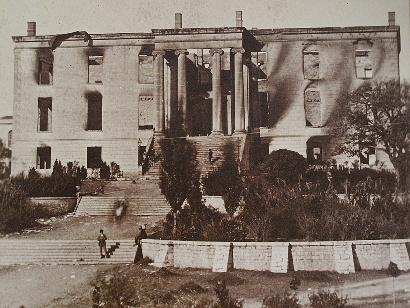|
Shortly
before noon on Nov. 9, 1881, the wind blew out of the north and a
light rain fell from a sky as gray as an old Confederate Army coat.
With the norther dropping the temperature, maybe the porter sweeping
the floor in the Attorney General’s office on the Capitol’s first
floor had in mind warming up the room. Or maybe Henry McBride just
wanted to get rid of a basket of wastepaper the easy way, by stuffing
the trash into the heating stove.
Whatever his intention had been, McBride moved on to the next room,
pushing his broom. But soon he smelled smoke. Running back into the
room where the stove sat, he found that pieces of burning paper and
embers had fallen onto the wooden floor. As he watched in astonishment,
the fire quickly spread. All he could do was run. |
First Texas State
Capitol Building
Vintage Photo Courtesy Texas State Library And Archives |
|
A writer for
Texas Siftings walking home for lunch noticed wisps of smoke coming
from one of the windows of the limestone statehouse. “That’s the
way those State officials waste firewood,” he thought, or at least
so he claimed in a tongue-in-cheek article he later wrote. “There
they are toasting their sinful shins before fires in which they
waste enough wood to do a respectable family for a week.”
But soon the fire bell atop City Hall began ringing. The number
of clangs informed the volunteer fire fighters—rushing to the
hall to get their equipment—that the fire was in the 8th ward,
downtown Austin. The limestone
capitol had been a bonfire waiting to happen.
Gov. Oran Roberts, remembering the 1865 robbery of the state’s treasury,
feared history was repeating itself. Holdup men must have started
a fire in the Capitol to divert attention, he thought. The governor
quickly ordered several Texas Rangers who had been camped on the
Capitol grounds to go guard the vault.
The only enemy on this day, however, was the natural consequence
of fuel, oxygen, and an ignition source.
“It was a thrilling
scene,” the next edition of Texas Siftings reported. “The fire’s
demon cruel tongues licked the fair proportions of the historic
pile, while huge volumes of black smoke poured from the doomed building,
and settled over the fair city…like a sable funeral pall, enveloping
in its somber folds the spires and domes that glitter on the several
hills of the Capital City…while the toot, toot, toot of the fire
engine, and the hoarse profanity of the enthusiastic volunteer firemen,
seemed a solemn and appropriate dirge as the old sarcophagus crumbled.
Low water pressure at the nearest hydrant, which was not all that
close due to the fact that two previous sessions of the Legislature
had not seen fit to appropriate money for fire hydrants on the Capitol
grounds, prevented the volunteer firefighters from putting much
more than a light mist on the blaze. In two hours, only a blackened
limestone shell remained.
|
 |
Capitol building
after it burned on Nov. 9, 1881.
Vintage
photo courtesy Murray
Montgomery Collection |
|
“The architectural
monstrosity…at the head of Congress Avenue is no more,” the Texas
Siftings famously summarized. “The venerable edifice that bore such
a striking resemblance to a large size corn crib, with a pumpkin
for a dome…took fire on Wednesday….”
Though newspaper reaction to the loss of the Capitol varied from
near indifference to open sarcasm, many government records dating
back to the days of the Republic burned in the fire. Geologic samples
and a collection of cultural artifacts, including shields and lances
seized by Indian-fighting Texas Rangers also went up in smoke. In
addition, 8,000 books were incinerated.
If the burning of the statehouse was truly Henry McBride’s fault
(he never denied the dubious honor, but someone else’s shoddy installation
of the stove pipe also played a role), the fire did not cost him
his job. He stayed on the state payroll until 1931.
When McBride died at 76 on April 8, 1936, the Associated Press,
which like the rest of the mainstream media in Jim Crow days did
not normally report the natural passing of African-Americans, distributed
a four-paragraph story noting the death of “the negro who indirectly
caused construction of Texas’ massive
granite capitol.”
In truth, though McBride may have accidentally started the fire,
state officials already had been planning for a new
Capitol, a grand structure that would be a much more fitting
home for the government of the nation’s largest state. But the fire
did speed up the process. Since the new
Capitol would be erected where the old one stood, the fire might
even have saved the state a little money in wrecking costs.
© Mike Cox
- October 18, 2012 column
More "Texas Tales"
|
|
|
